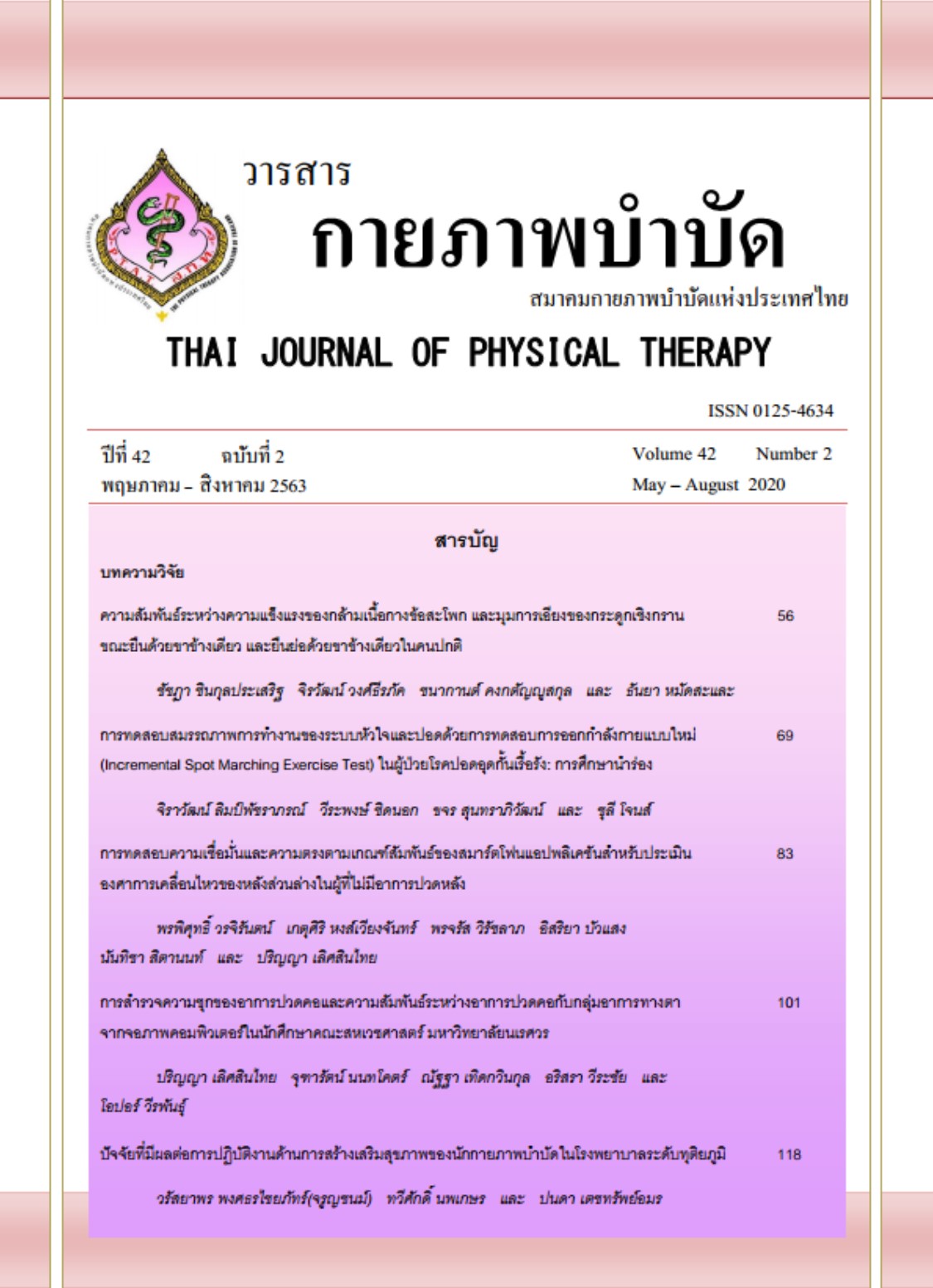การทดสอบสมรรถภาพการทำงานของระบบหัวใจและปอดด้วยการทดสอบการออกกำลังกายแบบใหม่ (Incremental Spot Marching Exercise Test) ในผู้ป่วยโรคปอดอุดกั้นเรื้อรัง: การศึกษานำร่อง
Main Article Content
บทคัดย่อ
ที่มาและความสำคัญ: การทดสอบการทำกิจกรรมด้วยการออกกำลังกายมาตรฐานส่วนใหญ่ เป็นการทดสอบโดยใช้ขาเป็นหลัก ไม่ครอบคลุมกิจกรรมที่ใช้แขนและขา อันเป็นปัญหาในผู้ป่วยโรคปอดอุดกั้นเรื้อรัง (Chronic obstructive pulmonary disease: COPD) การทดสอบการทำกิจกรรมด้วยการออกกำลังกายที่ใช้แขนและขาร่วมกัน จึงมีความสำคัญในการบ่งชี้สมรรถภาพการทำกิจกรรมทางกายที่สอดคล้องในชีวิตจริง ดังนั้น การทดสอบการทำกิจกรรมด้วยการออกกำลังกายแบบเพิ่มความหนักของการทดสอบแบบใหม่ (Incremental Spot Marching Exercise test: ISMET) จึงถูกพัฒนาขึ้น ซึ่งให้อาสาสมัครย่ำเท้ายกขางอสะโพก 70 องศาพร้อมกับแกว่งแขนสูงอย่างน้อย 90 องศา ด้วยความหนักของการทดสอบ (อัตราเร็วการย่ำเท้า) ที่เพิ่มขึ้น
วัตถุประสงค์: ศึกษาการตอบสนองและความสัมพันธ์ของการตอบสนองต่อความหนักของการทดสอบแบบ ISMET ของระบบหัวใจและปอดในผู้ป่วยโรคปอดอุดกั้นเรื้อรัง
วิธีการวิจัย: ศึกษาแบบตัดขวางในผู้ป่วยโรคปอดอุดกั้นเรื้อรัง ระดับรุนแรงน้อยถึงปานกลาง 10 คน เพศชาย อายุเฉลี่ย 64±5 ปี เริ่มการทดสอบแบบ ISMET ด้วย
อัตราเร็ว 70 ก้าวต่อนาที และเพิ่มขึ้น 10 ก้าวต่อนาที ทุก 3 นาที จนไม่สามารถทำต่อไปได้ ประเมินอัตราการเต้นของหัวใจ (Heart rate: HR), ปริมาตรอากาศของการหายใจต่อครั้ง (Tidal volume: VT), ปริมาตรการระบายอากาศต่อนาที (Minute ventilation: VE), และอาการหอบเหนื่อยด้วย Borg’s dyspnea scale (RPB) ในขณะพัก นาทีสุดท้ายของแต่ละความหนัก และสิ้นสุดการทดสอบทันที
ผลการวิจัย: เมื่อสิ้นสุดการทดสอบ พบว่า HR เพิ่มถึง 130±20 ครั้ง/นาที (83±22 % ของ HRmax), VT และ VE เพิ่มเป็น 1.48±0.25 ลิตร และ 47.27±9.54 ลิตร/นาที ตามลำดับ RPB เพิ่มถึงระดับ 4 (IQR 4, 5) พบความสัมพันธ์ระหว่างความหนักของการทดสอบแบบ ISMET และ HR, VT, VE, และ RPB (r=0.866, 0.899, 0.920 และ 0.861 ตามลำดับ) ผลลัพธ์ของการวิจัยทุกตัวแปรตามดังกล่าวมีนัยสำคัญทางสถิติ (p<0.01)
สรุปผล: การทดสอบแบบ ISMET เป็นการทดสอบสมรรถภาพการออกกำลังกายระดับความหนักปานกลางจนระดับสูงสุด โดยความหนักของการทดสอบแบบ ISMET นี้มีความสัมพันธ์ในระดับสูงกับการตอบสนองของระบบหัวใจและปอด การทดสอบแบบ ISMET เป็นการทดสอบที่ง่ายและปลอดภัย จึงอาจเป็นวิธีการทดสอบที่เหมาะสมในผู้ป่วย COPD ซึ่งควรศึกษาต่อไป
Article Details
เอกสารอ้างอิง
Global Initiative for Chronic Obstructive Lung Disease [GOLD]. Global strategy for the diagnosis, management, and prevention of chronic obstructive pulmonary disease [Internet]. 2017 [cited 2018 Oct 12]. Available from:https://goldcopd.org/wp-content/ uploads/2017/11/GOLD-2018-v6.0-FINAL-revised-20-Nov_WMS.pdf.
Rabinovich RA, Vilaró J, Roca J. Evaluation exercise tolerance in COPD patients: the 6-minute walking test. Arch Bronconeumol. 2004; 40(2): 80-5.
Stevens D, Elpern E, Sharma K, Szidon P, Ankin M, Kesten S. Comparison of hallway and treadmill six-minute walk tests. Am J Respire Crit Care Med. 1999; 160: 1540-3.
Guyatt GH, Thompson PJ, Berman LB, Sullivan MJ, Townsend M, Jones NL, et al. How should we measure function in patients with chronic heart and lung disease?. J Chronic Dis. 1985; 38(6):517-24.
Solway S, Brooks D, Lacasse Y, Thomas S. A qualitative systematic overview of the measurement properties of functional walk tests used in the cardiorespiratory domain. Chest. 2001; 119(1): 256-70.
Borel B, Provencher S, Saey D, Maltais F. Responsiveness of various exercise-testing protocols to therapeutic interventions in COPD. Pulm Med. 2013; 2013: 410748.
Owens GR, Thompson FE, Sciurba FC, Robertson R, Metz KF, Volmer RR. Comparison of arm and leg ergometry in patient with moderate chronic obstructive pulmonary disease. Thorax. 1988; 43(11):911-5.
McKeough ZJ, Alison JA, Bye PT. Arm exercise capacity and dyspnea ratings in subjects with chronic obstructive pulmonary disease. J Cardiopulm Rehabil.2003; 23(3): 218-25.
Dolmage TE, Maestro L, Avendano MA, Goldstein RS. The ventilatory response to arm elevation of patient with chronic obstructive pulmonary disease. Chest. 1993; 104(4): 1097-100.
Celli BR, Rassulo, J, Make BG. Dyssynchronous breathing during arm but not leg exercise in patients with chronic airflow obstruction. N Engl J Med. 1986; 314: 1485-90.
Janaudis-Ferreira T, Beauchamp K, Goldstein RS, Brooks D. How should we measure arm exercise capacity in patient with COPD?. Chest. 2012; 141(1): 111-20.
Borel B, Fabre C, Saison S, Bart F, Grosbois JM. An original field evaluation test for chronic obstructive pulmonary disease population: the six-minute stepper test. Clini Rehabil. 2010; 24(1): 82-93.
Pukdeechat M, Phimphasak C, Jones C. Effect of breathing with a new positive expiratory pressure device during exercise on exercise capacity and cardiopulmonary responses in patients with chronic obstructive pulmonary disease: Preliminary study. Thai Journal of Physical Therapy. 2017; 39(3): 97-110.
Pongpanit K, Jones C, Jones D, Boonsawat W. Positive expiratory pressure breathing increase the recovery of dyspnea in patients with COPD. Thai Journal of Physical Therapy. 2015; 37(1): 41-53.
Khaweephap V, Jones C, Phimphasak C, Jones D. Comparison of cardiopulmonary responses between a new spot marching test and six minute walk test in mild to moderate COPD patients. Poster session presented at European Respiratory Society International Congress 2016; 2016 Sep 3-7; London, United Kingdom. PA1592.
Naosang S, Wannachit N, Jones C.A new endurance exercise test “Spot Brisk Marching”: Lung capacity?.Poster session presented at The 8th National Physical Therapy Conference; 2016 Jun 20-23; Bangkok, Thailand.
American College of Sport Medicine. ACSM’s guidelines for exercise testing and prescription. 9th ed. Baltimore: Lippincott Williams & Wilkins; 2014.
American Thoracic Society and American College of Chest Physicians. ATS/ACCP Statement on cardiopulmonary exercise testing. Am J Respire Crit Care Med.2003; 167(2): 211-77.
Wasserman K, Hansen JE, Sue DY, Stringer WW, Sietrema KE, Sun XG, et al. Principles of exercise testing and interpretation: including pathophysiology and clinical application. 5th ed. Baltimore,ML: Lippincott William & Wilkins; 2012.
Luxton N, Alison JA, Wu J,Mackey MG. Relationship between field walking tests and incremental cycle ergometry in COPD. Respirology. 2008; 13(6): 856-62.
Hsia D, Casaburi R, Pradhan A, Torres E, Porszasz J. Physiological responses to linear treadmill and cycle ergometer exercise in COPD. Eur Respir J. 2009; 34(3): 605-15
Singh SJ, Morgan MD, Hardman AE, Rowe C, Bardsley PA. Comparison of oxygen uptake during a conventional treadmill test and the shuttle walking test in chronic airflow limitation. Eur Respir J.1994; 7(11): 2016-20.
Rabinovich RA, Vilaró J, Roca J. Evaluation exercise tolerance in COPD patients: the 6-minute walking test. Arch Bronconeumol 2004; 40(2): 80-85.


